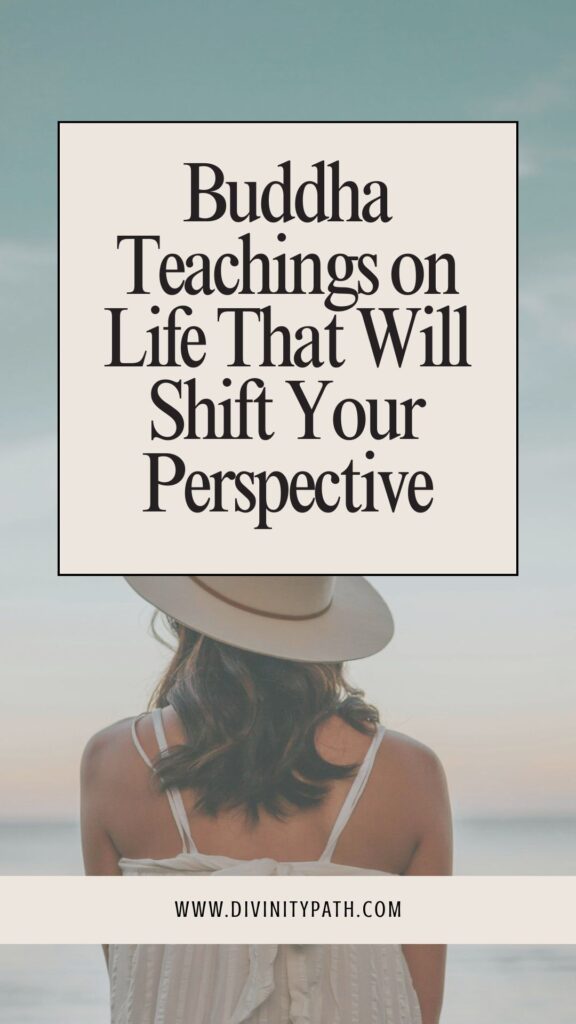Buddha Teachings on Life That Will Shift Your Perspective
Buddha’s teachings on life are surprisingly modern, practical, and understandable guides for everyday living — especially in times when we often feel lost in worry, comparison, and hurry.
Siddhartha Gautama, known as the Buddha, lived more than 2,500 years ago in India. He wasn’t a god but a man who wanted to understand why people suffer — and how to find inner peace. He gave up the luxurious life of a prince and set out on a long journey of seeking. When he reached enlightenment at the age of 35, he didn’t speak of miracles, but of truths that anyone can understand.
In this article, I’ve gathered some of his most well-known (and useful) teachings for you. Because they can change how you see anger, relationships, fear, and happiness. And because they can help you return to yourself — even in the middle of the most chaotic day.

10 Buddha Teachings on Life
1. Words Have Power – Choose Them Wisely
We know that words are more than just sounds or letters. According to Buddha’s teachings on life, they are actually a bridge between our thoughts and the world around us. Every thought we form can turn into a word, and words can either heal or hurt — the choice is ours. Buddha said: “You will not be punished for your anger; you will be punished by your anger.”
Think about it — when you’re angry and words fly out, no one suffers more than you. Words that come from a calm and compassionate heart have the power to transform not only others but also yourself. That’s why Buddha emphasized that we must be mindful of what we say, and that our words should always be truthful and kind. When you understand this, you begin to see your mind as a tool for inner transformation, where negativity has no place.
2. Happiness Is Not a Limited Resource – Share It Without Fear
Most people carry a deep fear that if they give something away, they’ll run out. But Buddha’s teachings show us the exact opposite. One of the most beautiful metaphors he shared is this: “Thousands of candles can be lit from a single candle, and the life of the candle will not be shortened.”
This means that happiness doesn’t need to be saved just for yourself — because sharing it doesn’t make it smaller; it spreads! When you understand this, you start connecting with people differently — no more competition, no more fear of loss. So let your happiness be a generous source — for your family, your friends, even strangers. This is one of the fundamental Buddha teachings quotes that reminds us of the abundance already within us.
You might also love:
- What to Do When You Constantly Worry About Losing Someone
- These Subtle Signs Reveal You Actually Love Yourself Deeply
- 11 Signs You’re Addicted to Drama (Without Even Knowing It)
3. Freedom Lies Beyond Courage – Fear Is an Illusion
Do you know why Buddha said, “The whole secret of existence is to have no fear”? Because fear is not something real, but an illusion that holds us back. In his teachings of Buddhism, he made it clear that true freedom is found when we stop fearing the future or the unknown.
When you’re ready to let go of fear and trust yourself, you open the door to a full, limitless life. Buddha teaches us that while seeking support from others is okay, true freedom comes from the awareness that we are responsible for our own lives. Once you realize this, you become the master of your world.
4. Truth Always Comes to Light
“Three things cannot be long hidden: the sun, the moon, and the truth,” said Gautama Buddha. And how right he was! In the Buddha teachings on life, one of the most important lessons is that we must always question what we hear or read.
Don’t believe something just because you heard it, because others say it, because it’s written in ancient books, or because a teacher told you so. Truth is something you must feel and understand for yourself. This is a very important part of Buddha’s teachings, encouraging personal growth and awareness. When you listen to both your mind and your heart, you can truly recognize what is right and what is not — and that leads you to real freedom.
5. Loving Yourself Is the First and Most Important Step Toward Real Love
We all want love, right? But Buddha teaches us that the greatest love is the one we first give to ourselves. It’s true — in the entire universe, there is no one more deserving of your love than you.
When we read books on Buddha’s teachings, we often come across this deep wisdom: “Love your neighbor as yourself” — but without self-love, that phrase remains empty.
Self-acceptance is the foundation of inner peace and healthy relationships. It doesn’t mean being selfish — it means allowing yourself the respect, warmth, and compassion that everyone of us deeply needs. So the next time you doubt your worth, remember Buddha’s teachings on life — self-love is not a luxury. It’s a necessity.
6. Spiritual Life Is Not a Luxury, but Fuel for the Soul
You know, spirituality isn’t something hidden only in temples or books — it’s the heart of our everyday life. Buddha said: “The way is not in the sky. The way is in the heart.” And it’s true — our inner growth doesn’t come from outside but from deep within.
In today’s world, where more and more people are overwhelmed with obligations, stress, and a fast-paced lifestyle, caring for our spiritual life gives us the strength and energy to truly live. Many therapists say that without this inner connection, we risk burnout and a deep sense of emptiness. That’s why it’s wise to follow the basic Buddha teachings that encourage us to overcome ourselves and seek peace within — not in the outside world.
7. Peace Is Not Found Outside, but Deep Within
If you’re searching for peace, you won’t find it in money, success, or even in relationships. True peace, says Buddha, comes from within. His teachings of Buddhism remind us: “Peace is the answer that comes only from within.”
Many psychological studies confirm that those who are able to calm their minds and manage their inner restlessness live more fulfilled and happier lives. Take a moment for silence, for listening to your heart. As a well-known quote from books on Buddha teachings says: “Better than a thousand hollow words is one word that brings peace.” And this kind of wisdom can only be felt when you pause and connect with yourself.
8. Friends Are Like Mirrors – Choose Them Wisely
We all know how important friends are. But Buddha’s teachings warn us to be mindful of who truly deserves that title. “An insincere and evil friend is more to be feared than a wild beast,” said Gautama Buddha. Why? Because a harmful friend can hurt your heart more deeply than any physical wound.
On the other hand, a good friend who points out your mistakes and supports your growth is a treasure we should cherish. So choose people who lift you up — not those who drag you down. Buddha’s teachings quotes remind us that friendship isn’t just about fun; it’s also a path toward inner balance.
9. We Are All Connected – Forget Labels and Prejudices
Did you know that the idea of separation is just an illusion? With great wisdom, Buddha emphasized that we are all part of one greater whole. “In the sky, there is no distinction between east and west,” he said — but people create divisions in their own minds. This realization is one of the most powerful in the Buddha teachings on life.
Keep exploring:
- 11 Everyday Habits That Quietly Make Your Anxiety Worse
- Simple Ways to Overcome Autumn Blues and Boost Your Mood
- Must-Try Autumn Self-Care Ideas for a Cozy, Joyful Season
When we start seeing the world as a connected web of beings, we learn to approach others with more compassion. So remember: the teachings of Gautama Buddha invite us to look beyond labels and feel this deep interconnectedness.
10. Happiness Is Not a Destination, but a Journey to Enjoy
We often think we’ll be happy once we reach that one big thing — the job, the relationship, the house, the family. But Buddha’s teachings show us something entirely different: “There is no path to happiness: happiness is the path.”
This wisdom appears in many books on Buddha teachings, where happiness is described as a daily process — not a distant goal. Just like a jar fills drop by drop, happiness is gathered through the small moments of everyday life. Enjoying the journey strengthens contentment more than chasing a big goal. So pause, take a breath, and realize that life itself is already a miracle worth enjoying.









